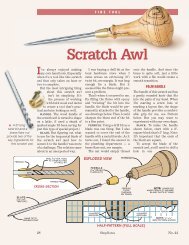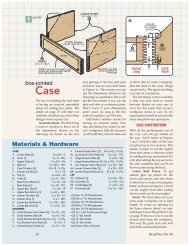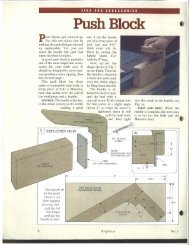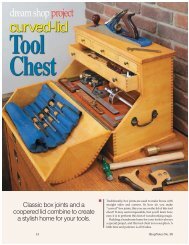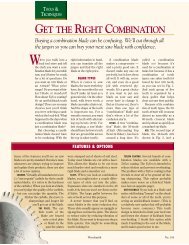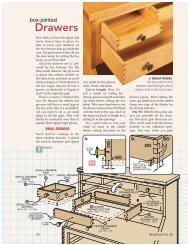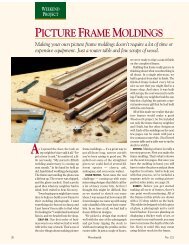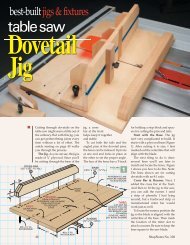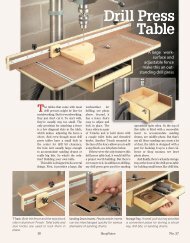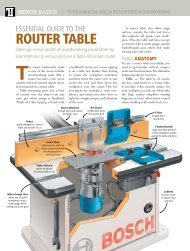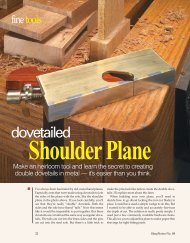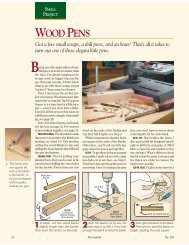Built-up Crown Molding - Woodsmith Woodworking Seminars
Built-up Crown Molding - Woodsmith Woodworking Seminars
Built-up Crown Molding - Woodsmith Woodworking Seminars
Create successful ePaper yourself
Turn your PDF publications into a flip-book with our unique Google optimized e-Paper software.
proportions right. And you can seehow the individual pieces can beassembled to make the molding.The molding shown on the oppositepage follows all the rules andmakes a good example of how to“build” a crown molding. As youcan see, it’s made in three sections.First comes a small, “bead andcove” profile that ties it to the cabinetand makes a smooth transition.Then, a large, simple cove section isused to add height and depth. Thecap, separated from the cove by fillets,is simply a roundover that endssharply to punctuate the crown.MATCH YOUR WOOD. Before talkingtechnique, I should mention a wordabout wood selection. The idea isto make the molding appear as if itwere all one piece. So you want topay attention to the color and grainmatch of the individual pieces.Whenever possible, it’s a goodplan to cut all the sections from oneboard. If necessary, you can use thepieces in different orientations —edge grain, or face grain. The routedprofiles do a good job of hiding anychange in grain direction.MAKING THE CROWNOnce you’ve designed the molding,the work is pretty routine. To makethe crown molding shown, I startedwith the large cove section.The top drawing at right showsthe process. The profile is cut witha 5 ⁄ 8 "-rad. cove bit. Elongating thecut creates the illusion of a largerradius. This is simply a matter ofcutting the cove to full width, thenraising the bit to extend the cut intothe workpiece. The bottom sectionactually ends <strong>up</strong> being flat, but the<strong>up</strong>per rounded section of the coveis what catches your eye.To do the work safely, I startedwith a wide piece of 1"-thick stock.This leaves you with plenty of surfaceriding against the fence as thecove cut is extended. When completed,the cove section is cut toheight on the table saw.A BEAD AND COVE. Next comes thesmall bead and cove piece that sitsbelow the large cove. The beadstands proud of the bottom edge ofthe large cove to add depth.Again, this small molding is madeon the edge of an oversized piece ofstock. The two middle drawings atright show the two steps involved.First, I cut the bead first with a singlepass across a beading bit. (Youcould also use a 1 ⁄ 8 " roundover bit tocut the bead in two halves.) Whencutting the bead, you’ll also createthe short fillet below that separatesthe bead and cove.The cove is routed with a 1 ⁄ 2 "-dia.core box bit. Just make sure to leaveat least a 1 ⁄ 16 " fillet separating theprofiles. Then I ripped the moldingfree, leaving it a little extra-wide tomake the final assembly easier.A SIMPLE ROUNDOVER. The top “cap”is routed on a wide piece with a 1 ⁄ 2 "roundover bit. You want the arc ofthe roundover to end sharply. Thisgives you a crisp end point at thetop of the molding, as shown inthe lower drawing at right. It alsoleaves a wide fillet along the loweredge of the piece that — when combinedwith the cove section below— adds a “stairstep” detail.ASSEMBLY. Once all the pieces aremade, the goal of the assemblyis two-fold — the molded edgesshould be aligned properly, andyou want the glue joints to be tight.The best way to get this done is toglue <strong>up</strong> only two pieces at a time.a.a.a.a.The keys to the glue<strong>up</strong> are plentyof clamps, cauls to distribute theclamping pressure, and a minimumamount of glue. There will bevery little stress on the glue joint, sostrength isn’t a big concern. I spreadthe glue sparingly, keeping it to theback edge of the joint and then let ittack <strong>up</strong> for a minute. Then align themolded edges (don’t worry aboutthe back face) and clamp the pieces,making sure they stay in place.Once the glue<strong>up</strong> is complete, theback face can be trimmed flush atthe table saw or jointer. And onceit’s installed on your project, onlyyou will know the secret of your“pieced” crown molding. Wwww.<strong>Woodsmith</strong>.com <strong>Woodsmith</strong> 49



